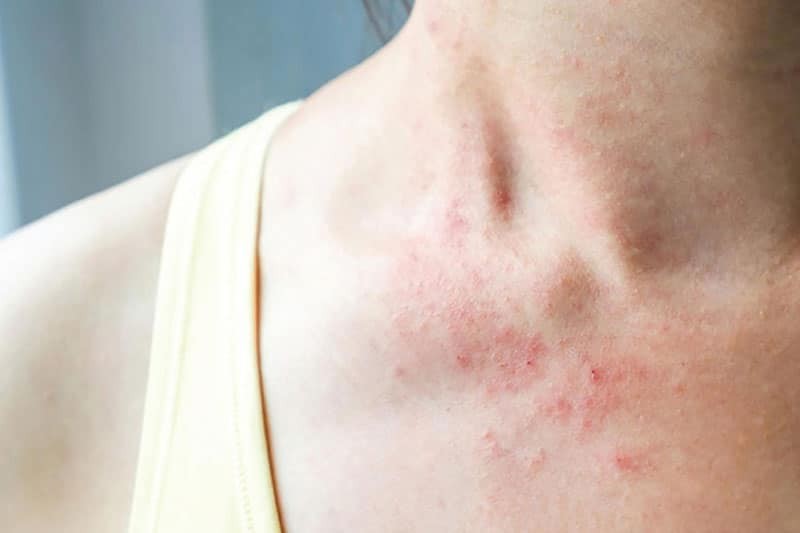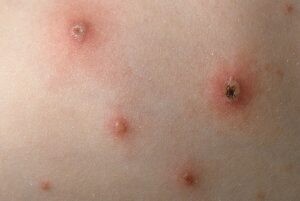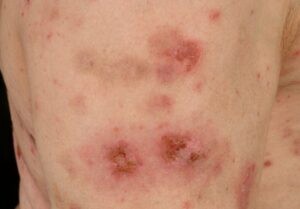What are blisters?
Blisters are raised structures on the skin surface, inside is clear fluid or pus if infected with bacteria. When these structures are larger in size, they are called bullae. These blisters or blisters can appear scattered all over the body (face, limbs, abdomen…). In addition, these blisters or blisters can be accompanied by local symptoms such as itching, burning or systemic symptoms such as fever, fatigue, muscle aches,…
To be able to detect and prevent the appearance of blisters.
Causes of blisters
Causes due to external factors
This is a normal allergic reaction and is not contagious. The triggers can be:
- Cosmetics: often due to expired cosmetics or cosmetics of unknown origin. Sometimes even benign cosmetics, but for people with allergies, can cause blisters on the hands and feet, the area where the cosmetics are applied. At this time, the patient may have a rash, severe even difficulty breathing, vomiting.
- Insects: Insect bites on hands and feet have the most typical symptom of blisters. The secretions from insects act as a foreign substance that enters the body and activates the skin’s immunity.
- Chemicals, dirt, polluted water
- Heavy metals: including Nickel, Cobalt,…
- Environment: in cases where the body cannot adapt to changing weather, humid environment, pollution, etc.
Caused by internal infection
If you have not come into direct contact with the above mentioned agents, you need to consider other unusual signs throughout your body. Because blisters may be just one of the pathological manifestations that your body is signaling to you.
9 common diseases that can cause blisters on the skin when contracted
Blisters are not a disease but a symptom. So what disease does blistering indicate? We can review 9 diseases that can cause blisters on the skin when contracted such as:
1. Herpes simplex virus infection
Herpes simplex virus infection is characterized by blisters on the lips and around the mouth and genitals. The blisters are also characterized by red, swollen, and painful skin. The blisters may burst, becoming infected and very painful.
In addition, you may also experience some systemic symptoms such as fever, muscle aches, swollen lymph nodes . After the disease stabilizes, there may be many recurrences later.
Please see a dermatologist or infectious disease specialist if you have the above symptoms.
2. Eczema – allergies
Blisters are a stage of eczema , often following a rash. In these cases, it is best to see a dermatologist. If necessary, simple topical or oral anti-allergy medications can be effective.

3. Chickenpox
Chickenpox , also known as varicella, is an infectious disease caused by the Varicella Zoster virus.
Initial symptoms may exhibit common characteristics of viral infections:
- Headache, muscle pain.
- Anorexia.
- Fever, sore throat .
- Tired, lethargic.
You may then develop blisters scattered all over your body. They are concentrated on your hands, back, arms, thighs, face, and may be more common around your natural openings.
The blisters gradually grow larger, often necrotic, creating a black dot in the middle. When you have a bacterial infection, they will turn into pustules. The disease can cause a very itchy feeling and can appear along the inside of the digestive tract, causing mouth ulcers and a very sore throat, making eating and drinking very difficult.
The disease has dramatic symptoms but is generally self-limiting. Rarely, some may experience dangerous complications such as chickenpox pneumonia and chickenpox encephalitis. Adults are at higher risk than children. However, the disease has specific medications and can be completely controlled.
Chickenpox is highly contagious and should be isolated from the community. See an infectious disease specialist or dermatologist early for the most effective treatment.

4. Herpes zoster
Shingles is also known as herpes zoster. This is one of the most common causes. When you have a history of chickenpox, these viruses can flare up again causing symptoms. The disease usually manifests as a rash and blisters on the body in strips. Accompanying symptoms are very painful, burning and uncomfortable.
In addition, patients may also have symptoms of fever, chills, muscle aches and loss of appetite. Although shingles mostly manifests with the above symptoms of rash and pain.
In some cases, shingles appearing in the eyes and ears can cause vision and hearing loss. In addition, shingles still carries the risk of causing pneumonia and hepatitis like chickenpox. These cases need immediate treatment to avoid unwanted complications.
5. Autoimmune bullous disease
Pemphigus is an autoimmune blistering disease that is technically called Pemphigus . It is caused by autoimmune antibodies that damage the skin and mucous membranes. There are different types of Pemphigus that are classified depending on the origin and location of the lesions.
These cases often have dramatic symptoms:
- Vesicles vary in size, usually large.
- Distributed in many places, some forms are concentrated in the upper body, in the folds of the limbs, and in sweat glands.
- Fragile, flaky, slimy and very painful.
- The skin may be red or normal.
Some are related to previous drug use. May be accompanied by other organ symptoms such as:
- Weight loss, poor appetite.
- Sore throat, difficulty swallowing, hoarseness .
- Nosebleed .
- Conjunctivitis.
- Difficulty urinating.
In general, this is a difficult and complex group of diseases with many different classifications. Please see a dermatologist as soon as you have suspicious signs.
Do you have other health questions that need advice? Follow the YouMed VN fanpage to read news, ask questions for free answers from doctors and learn about YouMed VN – a popular health management application.

Blisters and blisters are signs that should not be ignored. The cause can be as simple as an allergic reaction or eczema to other problems such as chickenpox or autoimmune. Do not ignore this symptom and seek medical examination and care immediately. Early treatment always gives much better results.
6. Prickly heat
Heat rash is common in children in hot weather due to their underdeveloped sweat glands. At this time, sweat and dirt are blocked, causing the skin to develop many small, pink bumps. Sometimes this condition is also caused by children wearing too many tight clothes in hot weather.
Prickly heat is a rash of red blisters as big as a pinhead, round or speckled. These blisters often appear on the head, neck, chest, back, etc., causing itching and burning and easily causing skin inflammation.
7. Water scabies
Scabies is characterized by blisters on the skin and the appearance of scabies grooves. These grooves are about 2-4 mm long and are where the scabies mite burrows and lays eggs. Scabies makes you very itchy, especially at night.
8. Hand, foot and mouth disease
Hand, foot and mouth disease occurs at all ages and is common in children. Blisters will appear in the full-blown stage with a diameter of 2 – 10mm, gray, oval. Blisters caused by hand, foot and mouth disease are often found on the palms, soles, knees, and buttocks. They are painless, do not itch, feel rough to the touch and can be raised or hidden under the skin.
In addition, you will experience additional symptoms such as vomiting and mouth ulcers. More severe symptoms include trembling hands and feet, rapid heartbeat, impaired perception, difficulty breathing, delirium, and convulsions.
Mild cases may resolve after 7-10 days of home care. However, if you have a fever that lasts longer than 48 hours, you should see a doctor.
9. Pemphigus
Pemphigus vulgaris is also the cause of blisters appearing all over the body such as in the mouth, scalp, mucous membranes, and genitals. Blisters caused by pemphigus often appear individually, not in clusters like other diseases. The fluid in the blisters is lemon yellow and causes an unpleasant odor. This fluid, after bursting, forms abrasions on the mouth of the blisters.
The risk factors for the disease are people aged 40-60 with underlying diseases. Patients have symptoms of weight loss, itching, and mouth pain when eating. These blisters will then continue to grow more and more. The blisters can last from 1 to several years with the disease if not treated.
What to do at home when you have blisters on your skin?
With blisters caused by external irritants, the blisters will disappear on their own after a while when contact with that agent is stopped. You can reduce itching caused by blisters at home by:
- Keep your skin hydrated by using a gentle moisturizer or applying aloe vera gel. This will help reduce swelling and prevent dry skin if the blisters break.
- If you have blisters, limit stimulants such as alcohol, tobacco, and spicy foods to reduce itching.
- Gently wash hands and feet with saline to remove some factors that cause blisters and limit infection and secondary infection.
- Use some specific drugs for the diseases that cause blisters
When should I see a doctor for blisters?
If blisters appear all over the body and show no signs of improvement, it is a serious condition. These are cases of allergies or having one of the 9 diseases mentioned above. In this case, to get rid of blisters, we must completely treat the source disease. And you should go to a dermatologist for examination and consultation for the best treatment.
In addition, if you have blisters in sensitive and difficult-to-treat areas such as the lips or genitals, you should also see a doctor because self-treatment can easily make the condition worse.
Things to know when having blisters on the skin
When you have blisters , you need to determine the exact cause of the disease for proper treatment. If necessary, you should consult a doctor for an accurate diagnosis. If your doctor prescribes medication, you need to follow the treatment plan. Avoid taking medication indiscriminately. You also need to pay attention to your diet, limit spicy foods, stimulants and drink enough 2 liters of water per day to help improve acne as quickly as possible.